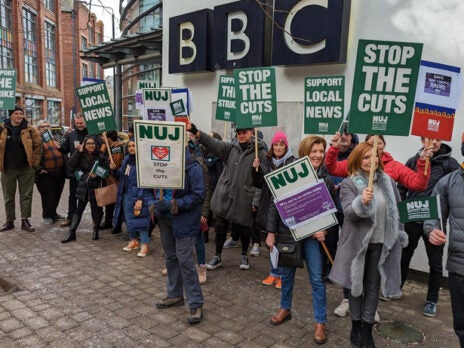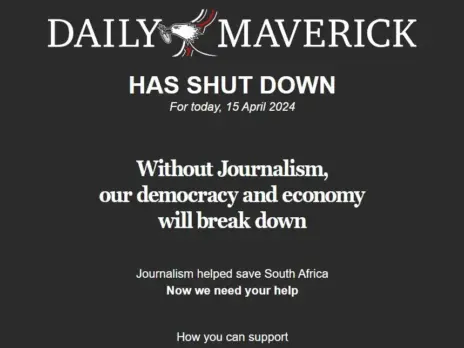
Kerrang! remains the best-selling weekly music magazine in the UK despite its sales declining 2.1 per cent year on year. It had 83,610 readers, well ahead of NME, according to the semi-annual circulation figures published last week.
But Radio Joint Audience Research (Rajar) figures revealed earlier the same day day showed that Kerrang! Radio’s listenership grew 19.3 per cent over the past year, to 1.4 million. And although Emap doesn’t publish ABCe certificates for Kerrang.com, the company claims that the site has 157,000 unique users each month.
In an industry keen to turn its magazines into cross-platform media brands, sometimes with integrated editorial operations, Emap’s onomatopoeically titled hard rock magazine is a particularly well-developed example of the concept in practice.
Less than half the profits of Kerrang! now come from the magazine’s advertising and circulation revenues. The largest share comes from the broadcast interests with online and mobile also contributing, said Stuart Williams, deputy managing director of Emap Metro-Music.
‘The website constitutes closer to 10 per cent, but it’s growing exponentially – and that’s the whole point,’said Williams.
‘The website is a great place to give extra life to content that we’ve created elsewhere. It’s where you can listen to radio shows if you’ve missed them, where you can go and argue about our reviews with your friends. It’s really the focal point of the brand.”
Most advertising revenue still comes from ad buyers using individual media, but Emap envisages a future where they buy cross-media packages at a premium, and individual media metrics are increasingly augmented by a measure of total cross-platform audience.
‘We don’t try to pull the wool over people’s eyes by just adding up all the constituent parts and presenting that as the total audience,’says Williams. Instead, audience research has established the degree of crossover between each audience group to present a ‘half-decent’estimate of the brand’s total audience.
‘It’s like a series of Venn diagrams – they all have their own unique audiences, but there’s a certain overlap at the middle,’he says.
Cross-media publishing also reduces some of the old certainties about who the competition is. Simple ABC league tables now tell only a sliver of the overall story.
‘It’s a whole new world,’said Rebecca Conroy, new media director of BBC Magazines.
‘In some cases it’s our traditional competitors. In motoring with Top Gear, our traditional competitor in print would be What Car; online it would be What Car as well, but then on top of that there’s also what MSN is doing, and what broadcasters and other publishers are doing, so it opens up the competition.”
The new competition could also open up new geographical markets.
‘When NME.com launched, people thought it would be Kerrang!, Q, Mojo and Uncut that we’d be up against,’says Anthony Thornton, editor-in-chief of IPC Ignite. Instead, he adds, the site found itself competing with US-based RollingStone.com. NME has opened offices in New York and Los Angeles and is posting news stories online well past midnight to cater for readers on the west coast of North America.
‘We’re looking for passionate music fans across the world. It’s not just a million or so people in the UK; it’s much, much more than that,’said Thornton.
And as publishers seek to extend their brands online, new media markets are becoming more crowded.
‘It’s become a more competitive marketplace in the past 12 months. Pretty much all the magazines that operate in the female space have launched websites,’said Nancy Cruikshank, managing director of Hearst Digital Network, Natmags’ digital publishing division.
Until about two years ago, Handbag.com and iVillage – with Condé Nast’s Vogue.com in the luxury niche – dominated the women’s online market. But portals AOL and MSN then started to compete with some original content, and some smaller titles, such as the Daily Mail’s Femail site, started to increase their online presence.
Competition for Natmags’ online title is also emerging from surprising new quarters, such as online bridal retailer Confetti, which has classified advertising and directory businesses.
For most magazines-turned-brands, cross-media simply means print and online. But even with just two groups in Williams’ Venn diagram, it remains difficult to understand publishers’ overall audience because the industry has yet to settle on a standard metric for website traffic.
Some momentum seems to be gathering behind ABC Electronic server audits. Days before the semi-annual ABC data was released, both BBC Magazines and IPC Media announced that they would be publishing ABCe figures for some of their websites together with the print circulation figures.
Until now, only a handful of national newspapers had been using ABC’s Group Product Reports, which include both print and online figures on a single document.
IPC released ABCe figures for NME.com, Nuts.co.uk and Loaded.co.uk.
‘We need to get behind an industry standard, because in the murky world of the internet, outrageous claims are made constantly,’said Thornton, the three sites’ editor-in-chief.
BBC magazines, meanwhile, released an ABC Group Product Report showing that Top?Gear.com had 1.08 million unique users in May, up 12 per cent year-on-year. RadioTimes.com, meanwhile, had 1.21 million unique users in May 2006, up 87.4 per cent year-on-year.
Emap publishes figures for FHM.com and Zooweekly.co.uk, and Natmags’ digital division is also planning to publish its ABCe audits, possibly as early as October.
‘We just need to get all our businesses on to the same ad serving and statistical reporting services, otherwise you can’t compare apples and apples, and it’s impossble to de-duplicate,’explains Hearst Digital Network’s Cruikshank. She adds that it is a ‘great shame’the market is still willing to accept publishers’ statements. ‘It would be great, over time, to move towards one methodology,’she says.
‘It’s important that, first of all, publishers to audit, and then we can continue to have the debate about how it’s done so that you can compare in a credible way.’
Email pged@pressgazette.co.uk to point out mistakes, provide story tips or send in a letter for publication on our "Letters Page" blog







